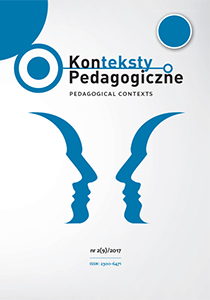Abstract
What constitutes good teaching has been at the focus of theories of pedagogy for thousands of years. However, recent research (Coe, Aloisi, Higgins & Major, 2014; Kornell & Hausman, 2016; Duke, 2012; Harmer, 2014; Grant, Stronge & Xu, 2014; Strong, Gargani & Hacifazlioglu, 2011; Hamre, Goffin & KraftSayre, 2009) suggests that this seemingly mature and wellresearched concept needs to be reexamined in view of the burgeoning research in the field. Coe et al. (2014) propose that recent research into best teaching practices brings up questions about elements of good teaching and ways of measuring it. The issue of evaluating teaching attempts to answer these seemingly obvious questions about what makes good teaching. This paper aims to address some of these questions. First, it examines the concepts of good teaching and the aspects which need to be considered in its evaluation. Next, it explores the frameworks determining good teaching which are delineated for different research and/or institutional needs. Based on the evaluation of these frameworks, the paper proposes a model for a specific set of needs of evaluating teaching from a student perspective at an Australian university.
References
Chubb, J.E. (2012). The best teachers in the world: Why we don’t have them and how we could. Chicago: Hoover Institution Press.
Coe, R., Aloisi, C., Higgins, S. & Major, L.E. (2014). What makes great teaching? Re-view of the underpinning research.Project Report. London: Sutton Trust.
Creemers, B.P.M. & Kyriakides, L. (2006). Critical analysis of the current approaches to modelling educational effectiveness: The importance of establishing a dynamic model. School Effectiveness and School Improvement, 17(3), 347–366.
Duke, R.A. (2012). Their own best teachers: How we help and hinder the development of learners’ independence. Music Educators Journal, 99(2), 36–41.
Ellis, E.S. (1993). Integrative strategy instruction: A potential model for teaching content area subjects to adolescents with learning disabilities. Journal of Learning Dis-abilities, 26, 358–383.
Ellis, R. (2015). Understanding Second Language Acquisition (2nd ed.). Oxford, United Kingdom: Oxford University Press.
Good Teaching Practice, http://www.flinders.edu.au/teaching/quality/evaluation/goodteachingpractice.cfm [accessed: 03.04.2017].Grant, L., Stronge, J. & Xu, X. (2014). West meets east: best practices from expert teachers in the U.S. and China, https://ebookcentral.proquest.com [accessed: 01.04.2017].
Hamre, B.K., Goffin, S.G. & KraftSayre, M. (2009). Classroom assessment scoring system implementation guide: measuring and improving classroom interactions in early classroom settings, https://www.vbgrowsmart.com/providers/Documents/CLASSImplementationGuide.pdf [accessed: 25.03.2017].
Harmer, J. (2014). The practice of English language teaching. Harlow, United Kingdom: Pearson Logman.
Kirschner, P., Sweller, J. & Clark, R. (2006). Why unguided learning does not work: An analysis of the failure of discovery learning, problembased learning, experiential learning and inquirybased learning. Educational Psychologist, 41(2), 75–86.
Klionsky, D.J. (2005). Points of view. Lectures: Can’t learn with them, can’t learn without them. Talking biology: Learning outside the book – and the lecture. Cell Biology Dducation, Winter, 3, 204–211.
Kornell, N. & Hausman, H. (2016). Do the best teachers get the best ratings?. Fron-tiers in Psychology, 7, 570.
Mayer, R. (2004). Should there be a threestrikes rule against pure discovery learning? The case for guided methods of instruction. American Psychologist, 59(1), 14–19.
MalczewskaWebb, B., Vallero, A., King, C.P. & Hunter, S. (2016). Breaking down the barriers of online teaching: Training TESOL teachers in a virtual environment. In: D. Gałajda, P. Zakrejewski & M. Pawlak (eds.), Researching second language learning and teaching from a psycholinguistic perspective (p. 237–259). Berlin: Springer International Publishing.
MalczewskaWebb, B. (2016). International students in Australia: What makes them happy? Student data from the positive education perspective. In: D. GabryśBarker & D. Galajda (eds.), Positive psychology perspectives on foreign language learning and teaching (p. 175–193). Switzerland: Springer International Publishing.
NCTQ Teacher Prep Review Standards and Indicators Traditional Teacher Preparation Program Standards, http://www.nctq.org/dmsView/NCTQ__Standards_and_Indicators__Traditional_Programs [accessed: 12.03.2017].
Online student evaluations, https://bond.edu.au/aboutbond/academia/learningteaching/onlinestudentevaluations [accessed: 25.02.2017].
Stillings Candal, C. (2015). Great teachers are not born, they are made: Case study evi-dence from Massachusetts charters. White Paper no. 130. Pioneer Institute for Public Policy Research.
Strong, M., Gargani, J. & Hacifazlioglu, O. (2011). Do we know a successful teacher when we see one? Experiments in the identification of effective teachers. Journal of Teacher Education, 62(4), 367–382.
Student evaluation of teaching policy, https://bond.edu.au/files/944/TLR207.pdf [accessed: 01.03.2017].
Vallero, A.J. (2014). Contrast and compare: direct and minimal guidance instruction. Sydney, Australia: The University of Sydney.
Webb, B. (2015). Bilingualism in the classroom: European students in Australia. In: K. OżanskaPonikwia & B. LorancPaszylk (eds.), Cross-cultural perspectives on bi-lingualism and bilingual education (p. 39–68). BielskoBiala: University of BielskoBiala Academic Publishers.
In accordance with the recommendation of the Ministry of Science and Higher Education, which aims to counteract the practice of “ghostwriting” and “guest authorship,” all authors submitting their text for publication should attach an author’s statement which declares the contribution of each of the authors to the article. The printed and signed statement should be delivered by mail or other means to editor-in-chief Joanna Skibska or sent in the form of a scan to the following e-mail address: redakcja@kontekstypedagogczne.pl. The authors will not receive remuneration for publishing their papers. The editors reserve the right to make minor editorial changes to the articles which will not affect the substance of the article. We encourage all authors to prepare their articles in accordance with the guidelines for manuscript preparation. Download pdf file.
Authors transfer all copyrights and grant the journal the right of first publication with the work simultaneously licensed under a Creative Commons Attribution License that allows others to share the work with acknowledgement of the work's authorship and initial publication in this journal. All authors agree to the publishing of their email addresses, affiliations and short bio statements with their articles during the submission process.

